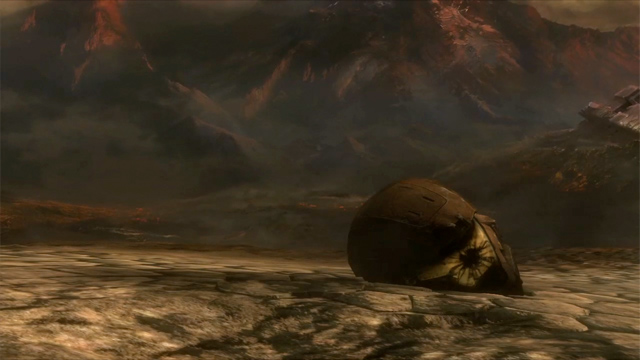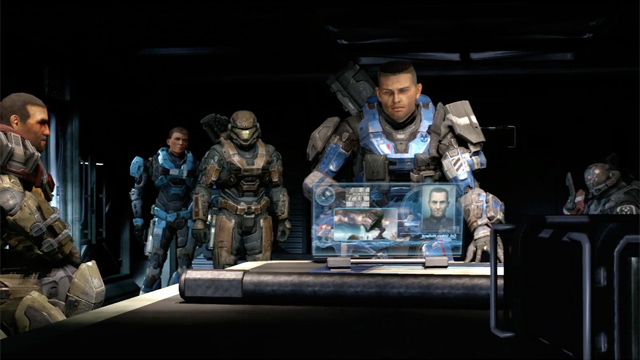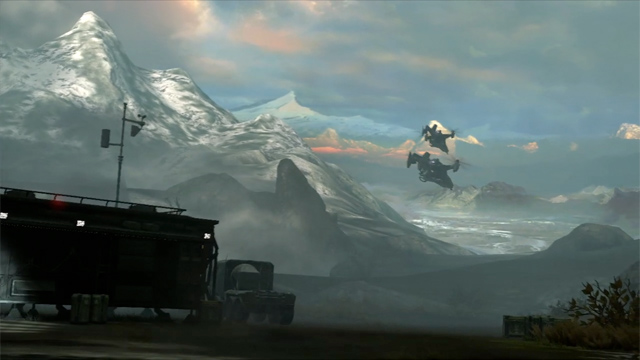Noble Actual
Cinematics in video games are a matter of economy. When the defining aspect of the medium is player interactivity, overly long movies tend to obstruct the chief appeal. At the same time, story and video games have never been so closely intertwined. The task of game developers is to relate the details without taking players out of the action for too long, which is never a particularly good idea. The best chance to deliver an impact is to hit the ground running with the opening video.
Halo: Reach takes its time delivering players to gameplay. The opening shot is of the planet Reach in ruins. Through systematic cuts closer to the surface, we see a battered, smoldering landscape devoid of life. The camera pans down from a view of a distant mountain and crashed ship to reveal a damaged helmet–your helmet. Every time to replay the mission, the armor changes to align with the player’s own customization.

The screen dips to white, and the word R E A C H appears as the music crescendos. The white flashback to the same helmet clearly sets the mood Bungie intended–from the beginning, you know the fate of the planet and of your own character.
The next minute of the cinematic is virtually identical to the debut trailer released at the Spike Video Game awards in December 2009; the newest member of Noble Team arrives as the rest of the group prepares for a mission. Those there are changes to the trailer, many significant, it’s worth noting how much of the original debut’s feeling is still there. The image is slightly grainy, dark, heavily atmospheric, and far more muted than virtually any environment ever seen before in a Halo game–even the parched and dusty fields of Uplift Preserve are more welcoming, or the belly of a Flood-infested ship. Nothing of major consequence has happened, but players already know this isn’t going to be like games that came before it.
While the player character drives into a UNSC base via Warthog, two Falcons fly overhead. The Falcon is Reach‘s replacement for Halo 3‘s Hornet. Early concept art suggests that it essentially began as a larger Hornet with an extended passenger cab and morphed into the vehicle we now know [1], adopting some traits from modern-day helicopters such as the Mil Mi-24. While supplanting the Hornet, the design has some similarities to the Hawks and Vultures from Halo Wars.
The first deviation from the VGA trailer is conspicuous–marksman Jun’s helmet is off as he loads his rifle and watches Noble Six arrive. Jorge’s helmet is also off as Holland briefs squad leader Carter on their mission. Reach represented a shift started in ODST where the masked characters revealed their faces as a key part of building relatable and identifiable characters. Creative director Marcus Lehto wanted the characters to have believable performances, which necessitated improved character animation, motion capture and lip sync, and rebuilding the Halo engine’s tech to accommodate that [2].

“We had to revamp the system so it isn’t cringe-worthy to watch these people talking to you. They don’t feel shallow and hollow.”
–Brian Jarrard [3]
A bit of changed dialogue from the trailer to the final product is significant; in the former, Jorge notes that he “didn’t think anyone survived Pegasi, sir,” a reference to Operation TORPEDO. During that mission, all but two Spartan-IIIs were killed in a mission to shut down a Covenant refinery on Pegasi Delta [Ghosts of Onyx, S02C08]. The line was the first indication that players would be assuming the role of Spartan-IIIs, not IIs as many had expected given the Fall of Reach timeframe. It was also a direct reference to an expanded universe event–the Pegasi operation was recounted in “Ghosts of Onyx”. The line was ultimately cut; material on Bungie’s site suggests that Noble Six, like the other Spartan-IIIs of Noble Team, were saved from deaths in TORPEDO and PROMETHEUS by the intervention of Mendez and Ambrose, and thus Noble Six would never have been involved in the carnage on Pegasi [4].
As the Spartans climb into Falcons to head off on their mission (assaulting the already-present Covenant in the trailer, investigating the downed relay in the game cinematic), Carter tells Noble Six that while he’s glad to see his team operating at full strength, the “lone wolf” operations that Six is known for are no longer acceptable. Part of this warning may stem from the loss of Thom-234, for whose loss Kat and Carter blame themselves. Notes on Bungie’s site indicate and the “Deliver Hope” TV shot indicate that Thom took it on himself to engage hostiles alone and was killed. Carter doesn’t want a repeat, although the game’s events will ultimately bring the same scenario to pass.
Worth noticing in this first cinematic is the very deliberate editing and cinematography choices. As Noble Team’s Falcon’s lift off, the camera shudders, as if being hit by gusts of air, and its tracking of Noble Team across the sky is not perfectly smooth, suggesting that an actual person is recording those events rather than an omniscient camera. Virtually every shot in “Noble Actual” has some degree of bobbing to it, as if every angle was a different handheld camera. The game even observes some anachronistic news conventions–like Holland’s static portrait in every computer terminal.
“…since it’s a human story… we wanted to justify the camera [in every scene], not so much have some flying, romantic camera.”
–Lee Wilson, Cinematics Lead [Reach Legendary Commentary]
The shot of Jun loading his weapon is also an example of a cinematic oddity–the axial cut, a type of jump cut. In filmmaking jump cuts often violate continuity, especially if they violate the so-called 30 degree rule–the camera should move at least 30 degrees between shots of the same subject, otherwise it draws attention to itself. Bungie has used cuts like this before–there are several examples in Halo 2‘s opening cinematic, and another is Johnson’s appraisal of the Chief in the Halo 3 “Arrival” cutscene. In modern films moviegoers might be most familiar with axial cuts for “moment of realization”-type shots or jarring moments. We see less-dramatic instances of this use of axial cuts in Reach, but its use for Jun is much more in the signature style of Kurosawa–stressing a simple gesture and lengthening time.
Of note in this cutscene is the persistence of the player character–not only does the armor change every playthrough to synchronize with the multiplayer armor, but players were for the first time able to pick their character’s gender in the campaign–and, have characters refer to him or her in the proper terms.
I wanted to make sure both male and female were treated equally as far as player character was concerned and you could really open up the audience, hopefully, to a broader group of folks.
–Marcus Lehto [5]
Given Bungie’s affinity for cinema and the number 7, it’s not surprising that there were originally going to be seven members of Noble Team to correspond to the doomed characters of The Seven Samurai. Thom and Rosenda were ultimately cut from the game, becoming briefly mentioned in the game’s supplemental materials–Thom becomes the deceased member of Noble Team, while Rosenda is another active Spartan who is considered as another replacement for Emile. The most likely explanation for their cuts was that there wasn’t enough time to flesh out any more characters.
Another important element that fans immediately noted was the variation in Noble Team’s armor. The variations between each character’s armor and helmet types–down to the color of their visors–is a shift from prior descriptions of Spartan-IIs or IIIs, who were clad in the same gear. Only people such as Spartan “mother” Catherine Halsey could usually tell them apart in their identical armor [First Strike, S01C13].

As the Falcons carrying Noble Team head into the distance, the music fades to a single sustained note while the image fades out. O’Donnell’s music in this opening and throughout the game is remarkably different from previous scores. While ODST departed from the standard Halo sound by using film noir smoky saxophones and quieter beats. Likewise, Reach discards almost every single theme found in Halo previously, reserving slight snippets of the trilogy’s main theme for spare moments through the campaign. Whereas the previous games were usually driven by strings (and in Halo 3‘s case, piano), Reach features a robust and bombastic brass sections–mournful horns used as in Noble Actual’s beginning to accentuate the devastation and sense of loss. The percussion section too is heavily emphasized.
Players have been introduced to their main characters, and in the next mission they get to see them in action. This is the quiet before the storm.

Great read! I really enjoyed looking at the target render from the initial reveal and comparing it with the final produce. I think they came pretty close tbh.